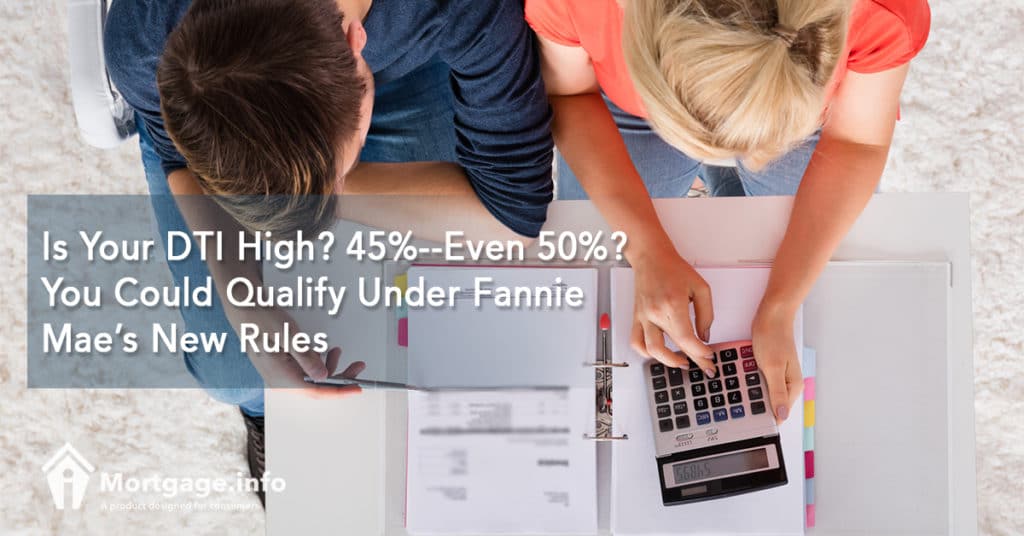With the recently higher property values and record levels of debt in America today, many applicants have been pushing the upper limits of allowable debt-to-income (DTI) ratios. High DTI ratios have always been an issue, an impediment even to getting a mortgage.
But the July 29th release of Fannie Mae’s Desktop Underwriter® makes it possible for many applicants who didn’t qualify before to now qualify because of an updated risk assessment that allows for higher debt-to-income ratios.
Under DU® Version 10.1 release, Fannie Mae increased its maximum allowable DTI ratio to 50%. This reduces the number of borrowers who may have been shut out of mortgages for this reason and increases the chances for them to become qualified for conventional financing.
Stakeholders in the mortgage industry have hailed the boost in the debt-to-income ratio cap as one way to expand credit access for many more Americans with little risk on the part of taxpayers. Newly qualifying borrowers in the 45 to 50 percent DTI range will disproportionately improve the qualifying opportunities for black and Latino families. Interestingly, studies show that the default rates for loans in this range are only very slightly higher than lower DTI loans.
A win-win situation, indeed.
[sc_content_link label=”Take advantage of this improved risk factor as well as other eased guidelines. Ask a lender today.”]
Maximum Allowable DTI Ratio Increased to 50%
Fannie Mae recently adjusted its allowed debt-to-income ratio to a maximum of 50%, from 45%.
Borrowers with DTI ratios above 45%, but not exceeding 50%, will no longer need additional compensating factors under Fannie Mae’s updated guidelines.
With this positive change, borrowers can enjoy the following perks:
- Increased Purchasing Power: Enabling borrowers to buy a home with a larger loan amount. Buy that home that was just out of reach before the changes.
- Qualify with Existing Debts: Consumers burdened with student loans, personal loans, auto loans, and credit cards usually have high DTI ratios. This will open the credit box for them. Many borrowers with “too-much” debt before, now qualify.
- Qualify for Higher Debt-Consolidation: The higher DTI threshold can allow more borrowers to refinance consolidate debts, for home improvements, or take out cash for any other reason.
DU®’s risk assessment has been updated so it can accurately evaluate borrowers with high DTI ratios without changes to their borrower profile. The risk assessment has been made easier for all applicants and results in the automated Desktop Underwriting recommendation.
The updated risk assessment along with the adjusted DTI ratio cap will result in dramatically more loans getting an Approve/Eligible recommendation from Desktop Underwriter®.
DTI is one among many risk factors used in evaluating a borrower’s willingness and ability to repay his/her mortgage.
Other factors evaluated by DU® for creditworthiness are credit history, loan-to-value ratio, delinquent accounts, installment loans, revolving credit utilization, public records, foreclosures, collections, and liquid reserves.
Assessing Risk and Eligibility
In addition to the automated risk assessment, there are many eligibility guidelines required to make loans eligible for purchase by Fannie. One is the DTI ratio.
Previously, loans having DTI in the 45% – 50% range were eligible if certain compensating factors were present. Qualifying in that range was rare. Those with ratios in the 45% and 50% range could be eligible if they satisfy the following requirements: (i) 12 months’ worth of reserves and (ii) LTV of 80% or below.
The release of DU Version 10.1 pretty much replaces this previous DTI eligibility guideline. Effective July 29, those with DTI ratios up to 50% will be evaluated using the updated risk assessment without the need for additional requirements.
[sc_content_link label=”Shop and compare mortgage loans and rates here.”]
What is your DTI ratio?
How much more do you qualify for now versus the previous guidelines?
Your DTI is the ratio of your housing expense and monthly debt payments relative to your gross monthly income. To get your debt-to-income ratio, the lender will determine your total monthly housing expense (principal, interest, HOA, MI or PMI and one twelfth of taxes and insurance). Add to that any monthly debt obligations from credit (as well as those not reported to credit yet), and any other recurring rent or debt payments (not including utilities). These amounts are divided by your total qualified gross income before taxes. Knowing what qualifies for income is another full set of sometimes complex guidelines your lender can help you understand.
In essence, your debt-to-income ratio says whether you can comfortably pay your mortgage with the existing debts you have and given the income you have.
A higher DTI will mean a higher level of risk, a lower DTI means lower risk. The DU risk assessment has been modified accordingly to address the risk found in loan applications with up to 50% debt-to-income ratios.
When refinance borrowers have debts pushing their ratios over 50%, sometimes the best solution is to pay those debts through a debt-consolidations refinance and lower their ratios.
Similarly, purchase borrowers might need to pay off certain debts to drop their ratios at or below 50% when buying a new home.
Under Fannie Mae’s guidelines, an application with a high DTI ratio can still receive a “Refer with Caution” recommendation from DU® if combined with a high loan-to-value ratio, zero reserves, and a low credit score. Those borrowers can still hope to accomplish a manually underwritten approval.
While you can now benefit from the increased threshold for DTI ratios when seeking a conventional loan, it’s still important to always try to attain low and healthy DTI ratios to ease the pressures of your personal budget and to accommodate for future borrowing needs.
[sc_content_link]

